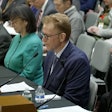Given a decade's worth of legislation that has dramatically affected the practice of radiology, to all appearances radiologists are an afterthought in the decisions that affect their daily practices, according to an opinion published in the May issue of the American Journal of Roentgenology.
To correct the situation, radiologists must increase their efforts in health services research, said lead author Dr. Christoph Lee, of the University of California, Los Angeles (AJR, May 2011, Vol. 196:5, pp. 1111-1114).
"We have to show sound evidence through health services research and reassert our expertise over all facets of medical imaging, including issues of quality, appropriateness, access, safety, patient quality of life, and cost," Lee wrote, along with co-author Dr. Howard Forman from Yale University. "If we do not, then other specialties without our inherent insights will, and we will remain on the outside looking in."
Health services research combines scientific investigation across many disciplines to assess how health technologies -- as well as social, fiscal, and organizational factors --affect access to healthcare and its quality and cost. Clinicians from other specialties have long outpaced radiologists in developing new methods for evaluating emerging technologies and quantifying their contribution to patient care, the authors wrote. But with the new reality of healthcare reform, health services research for radiology is no longer a choice, but a mandate.
"With increasing demands from the federal government, the health insurance industry, and the general public for increased efficiency and effectiveness for healthcare dollars spent, it is no longer enough for radiologists to understand just the imaging findings," they wrote. "All of us will need to understand how our imaging impressions and recommendations impact patient care on the individual and population levels and show our added value to multiple stakeholders."
Where can this training happen? In the academy, according to Lee and Forman.
"Academic departments of radiology can and should create sustainable divisions of health services research," they wrote.
Relegated to dark rooms?
There aren't enough radiologists who understand this health services research imperative, according to Lee. Most are used to being relegated to dark reading rooms and rarely having contact with either patients or referring physicians.
"Radiologists tend to take the back seat," Lee told AuntMinnie.com. "And the unfortunate consequence is that radiologists have taken big hits to their stature and their financial compensation in the current era of healthcare reform. We've got to demonstrate how much value the services we contribute provide."
Lee suggested that radiologists also reach out to fellow clinicians in other departments, taking time to explain what a radiologist does for patients on a daily basis and, therefore, becoming more involved in clinical decision-making discussions.
"For radiologists to continue to thrive, we're going to have to show our faces more and explain exactly what we do," he said.
Follow the money
The American Recovery and Reinvestment Act (ARRA) of 2009 set aside more than $1 billion for developing a framework for comparative effectiveness research, according to the authors. And the Patient Protection and Affordable Care Act (PPACA) of 2010 offers financial incentives for new payment models that will reward organizations that lower overall medical costs.
Both of these legislative changes give radiologists the opportunity to increase their health services research efforts. Radiology health services researchers could take the following steps:
- Guide advances in automated decision-making tools.
- Design ways to decrease the inappropriate use of imaging with appropriateness criteria incorporated into intelligent computerized physician order-entry systems.
- Demonstrate short-term and long-term cost-effectiveness or cost-savings of imaging procedures for patients and insurers.
- Show the value for reimbursements through comparative effectiveness studies versus more invasive surgical procedures.
- Lead the development of monitoring systems for radiation dose.
This isn't work for nonradiologist researchers: Radiologists themselves need to do it, according to the authors. Radiologists have long reacted to policy decisions such as the Deficit Reduction Act of 2005 (which cut $2.8 billion in payments over five years for imaging services) and the U.S. Preventive Services Task Force (USPSTF) 2009 guidelines for screening mammography -- rather than shaping them.
"The most influential of health services researchers continue to be the leading practitioners in their respective specialties," they wrote. "Clinical radiologists are consulted daily by the full gamut of generalists and specialists and are in an excellent position to contribute to solving systemic problems in health services with a unique, panoramic view of an entire patient population."



















